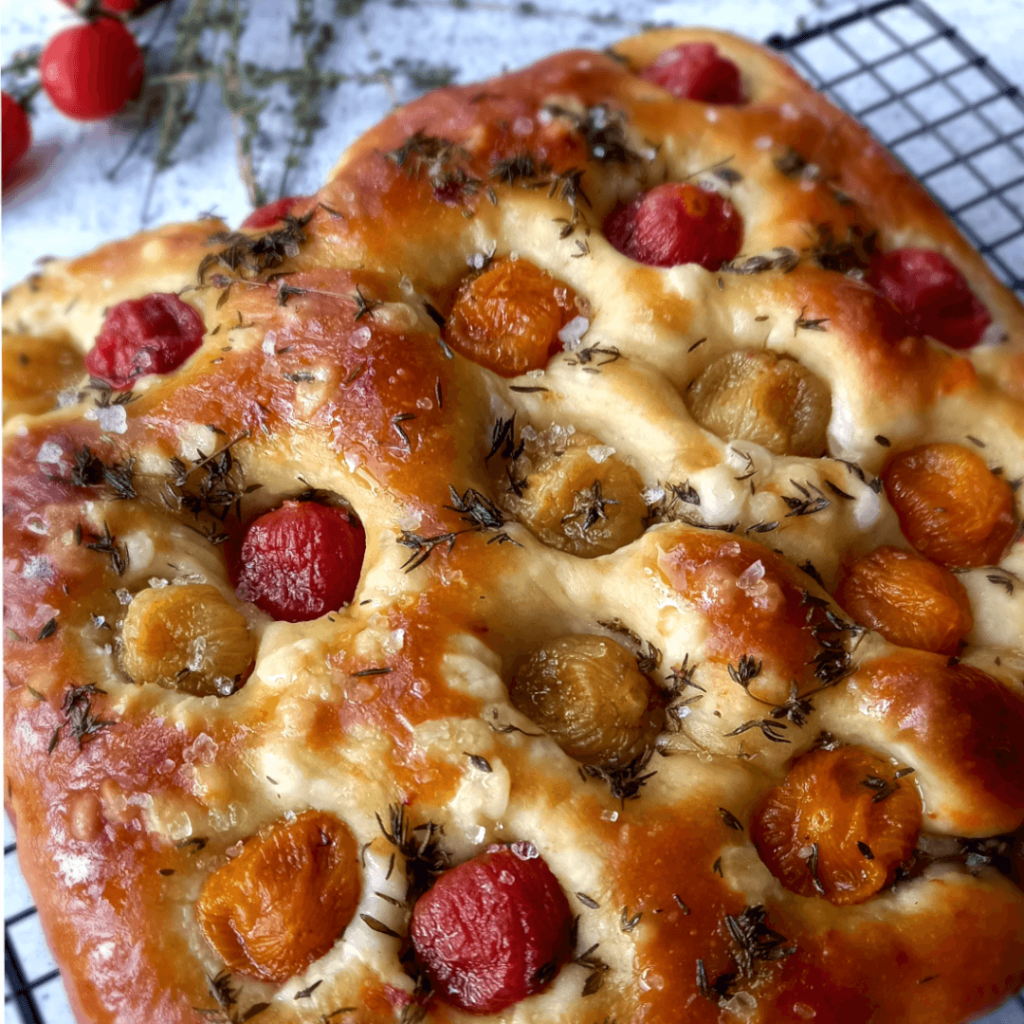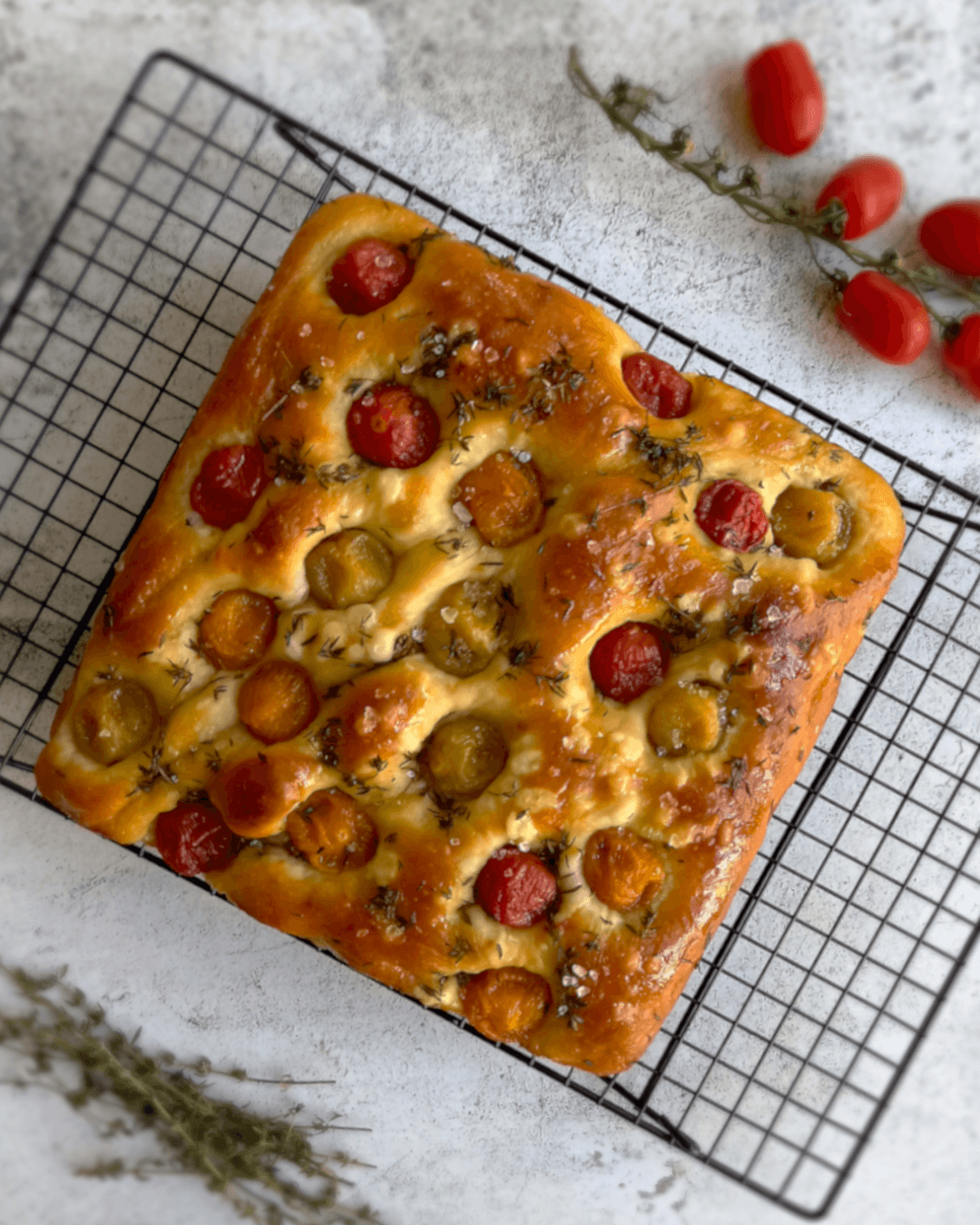Focaccia, focaccia, focaccia.
Sometimes I dream about focaccia. I still remember that one time that I visited Genova and Liguria, I couldn’t stop eating it. For breakfast, snack, lunch, snack again, dinner. It was just so incredibly good.
Lately, there has been a focaccia boom outside of Italy as well. Happiness, happiness, happiness. However, the quality of most focaccia(s) I have tried is so poor that I am really surprised it has caught on so much. Incredibly, the boom seems to be linked more to the inviting appearance – yep, it looks really good – and the amount of toppings – yep, you can put pretty much anything on focaccia – than to the actual quality of the dough.
But if you’re here reading this, you know too well that the proof is in the dough. The actual bread. That’s why we’re all here. A good focaccia recipe.
This time, I’d like to start with a disclaimer first: in my opinion there is no other way to achieve perfection than by using slow fermentation. On top of that, I’ve been working on my version of a sourdough focaccia for months now, and the eureka moment is around the corner, but not quite yet. Can’t disappoint nonna though.
However, sometimes we need some quick fixes, and that is ok, if that’s achieved without sacrificing taste and consistency. The other day I needed some good old focaccia to share for a party, so given the ‘unhappy-nonna sourdough focaccia attempt’ and the ‘oh-my-god-I-don’t-have-enough-time problem’, I went for an old 1-afternoon easy recipe of mine. It still requires a bit of patience but can be easily done both kneading by hand or using a stand mixer. Last but not least, ok, yes, I wanted to impress, so I decided to use some rainbow cherry tomatoes (some of them from my own garden) and to give them a pickled twist, plus some lovely fresh thyme as toppings.
Result? My pickled rainbow cherry tomatoes and thyme focaccia is soft and fluffy, with a slightly tight crumb and tender crust, perfect to eat on its own or for an Italian style sandwich – just some prosciutto would do the trick here. However, don’t dare overstuff it, thyme and tomatoes are already playing the supporting actor role after all (nonna’s rule, sorry).
Nothing left to say. See you on the seriously good side of focaccia.
Focaccia lover? Try also my garlic oil and fresh thyme potato focaccia, another easy recipe that won’t let you down at the party.

Makes 1 focaccia
Ingredients
FOR THE THYME INFUSED OIL
- 50ml extra virgin olive oil
- 2 tbsp fresh thyme leaves
FOR THE PICKLED CHERRY TOMATOES
- 20 cherry tomatoes
- 100ml sherry vinegar
- 100ml water
- 100g sugar
FOR THE FOCACCIA DOUGH
- 450g strong white bread flour
- 280g water, at room temperature
- 50g full-fat milk, at room temperature
- 10g salt
- 10g castersugar
- 7g instant yeast (2 tsp)
- 50ml extra virgin olive oil
- 5g coarse sea salt (1 tsp)
SPECIAL EQUIPMENT
- Spray bottle filled with water
- plastic / metal dough scraper
Method
MAKE THE THYME INFUSED OIL AND PICKLED CHERRY TOMATOES
- Mix the thyme leaves with the oil and set aside.
- Bring a pan of water to the boil. When it’s bubbling, add the tomatoes (you do not need to score them first) and let them blanch for about 1 minute (or until when the skin starts to peel back). Using a spoon, take them out of the water and put them in a bowl filled with iced water (or very cold water). Let them rest for 1-2 minute and then peel. The skin should come away easily. Put the peeled cherry tomatoes in a small bowl and set aside.
- Add the vinegar, water and sugar to a small pan and bring to the boil, giving it a good stir to dissolve the sugar. Let it boil for 1 minute, then remove from the heat. Let it cool down for 5 minutes. Pour the vinegar mix onto the cherry tomatoes and cover the bowl. Let it rest at room temperature.
MAKE THE FOCACCIA DOUGH
- Sift the flour into a bowl and add the sugar and salt, mixing for a few seconds to evenly distribute it. Add the water, milk mixture and instant yest, and mix in a stand mixer on low for 5 minutes until you get a rough dough and all dry crumbs have been incorporated. If mixing by hand, you can use a fork.
- This is a very sticky dough. Turn up the speed of the mixer to medium and knead for another 7 minutes, until the gluten starts forming and the dough is less tacky. If kneading by hand, they way to go is to work fast, slapping the dough back and forth onto itself, using only one hand, keeping the other clean to use a scraper to gather the dough when needed. Resist the urge to add more flour, after 7 to 10 minutes you will notice that it will be way less tacky and you will be able to gather it in a rough ball using the scraper.
- Take a clean bowl, add the 50ml olive oil in it and twist so the sides coat evenly. Transfer the dough into the oiled bowl, and add another spray of oil on the top, so the dough is coated with oil and won’t form a skin. Cover with cling film and leave to rise for 3 hours in a warm place (recommended temperature 28°C), performing a ‘stretch and fold’ every 30 minutes for the first 2 hours (dip your fingertips into some oil and stretch the dough from each end and then fold it letter style on itself and towards the centre).
- Take the tin you are going to use to bake your focaccia, and ligthly oil the surface. I usually like to go for an extremely thick focaccia for this recipe, so I would normally use a 20x20cm square tin, but you can choose whichever shape and side you like. Just remember that is going to affect the thickness of your focaccia.
- Uncover your dough and, using a scraper or oiled hands, gently transfer it to the oiled tin. Very gently press the dough to evenly spread it across the tin, making sure not to break the bubbles that have formed inside. Do use only your fingertips and not the palm of your hands, to avoid ripping the dough, and don’t worry if you are unable to fill the tin you’ve chosen, the dough will relax and fill the corners during the second proofing. Cover with cling film and leave to proof for 1 hour in a warm place (recommended temperature 28°C). In the meantime, heat the oven to 230°C.
- After 1 hour, remove the cling film and pour the 25ml (half) of the thyme infused oil (alongside the thyme leaves) over the focaccia dough. Using your fingertips, gently dimple the dough from top to bottom making the typical focaccia holes, distributing the oil evenly. Using a colander, remove the tomatoes from the marinate and scatter them over the focaccia, driving them down to sink into the dough a little.
BAKE AND FINISH THE FOCACCIA
- Sprinkle the focaccia with salt. Transfer to the oven, spray the sides and bottom of the over with water to generate steam and bake for 15 minutes, until tall, fluffy and perfectly golden. Once baked, take out of the oven and immediately brush with the remaining thyme oil. Finish the focaccia by breaking and distributing more sprigs of fresh thyme all over it, as a decoration. Then, just enjoy.

